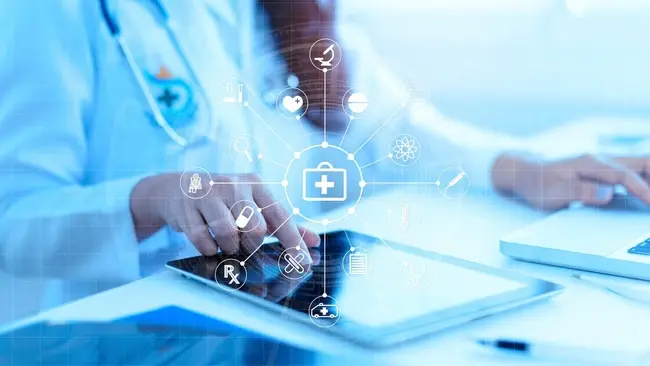The healthcare system is in crisis. Rising costs, a growing population with chronic conditions, and limited accessibility are putting immense strain on the entire industry. But there's a powerful force driving positive change – health technology.
Also known as health tech, this new field harnesses the potential of technology to transform healthcare, aiming to improve access, deliver more personalized care, and ultimately create a healthier future for everyone.
In this article we explore what is Healthcare Technology, Healthcare Information Technology and the benefits of implementing technology across the health field.

What is Health Technology
Health Technology is the application of technology to improve healthcare. Also known as ‘Health Tech’, it encompasses a wide range of tools and advancements, from traditional medical devices to cutting-edge fields like machine learning and generative AI.
From AI-powered diagnostics to personalized medicine and remote patient monitoring, healthtech is set to revolutionize how we deliver, experience, and manage healthcare.
It's a future where patients are empowered, providers are more efficient, and the healthcare system is more cost-effective.
Types of Health Technology
Health tech is an umbrella term that covers many different areas that each target different pain points faced by the healthcare industry.
Digital Health
Digital Health focuses on leveraging digital tools and software to improve healthcare delivery. Telehealth, mobile health apps, and electronic health records (EHRs) are all part of digital health. It encompasses the use of information and communication technologies (ICT) to streamline healthcare.
Read: What are Digital Therapeutics
Medical Devices
Medical Devices are traditional and technologically advanced medical equipment. They are a crucial component of healthtech, playing a vital role in diagnosis, treatment, and patient care. They encompass a wide range of instruments, equipment, and implants, categorized by their function and level of invasiveness
X-ray machines, MRI scanners, ultrasound devices, and CT scanners create detailed images of internal organs and tissues, aiding in early detection and diagnosis of diseases. Whilst In Vitro Diagnostics (IVDs), like glucose meters for diabetics, are performed on samples like blood, tissue, or fluids to diagnose diseases, monitor conditions, and assess treatment effectiveness.

Health tech also facilitates advanced laparoscopic and robotic surgery tools that allow for minimally invasive procedures, leading to faster recovery times and reduced pain for patients as well as stents and implants to open blocked arteries, support structures, or deliver medication directly to targeted areas.
Wearable Devices like fitness trackers, smartwatches, and continuous glucose monitors (CGMs) collect real-time health data like heart rate, blood pressure, and blood sugar levels. This data can be used by patients and healthcare providers to monitor chronic conditions and adjust treatment plans as needed. Remote Monitoring Devices are often paired with wearables, transmit health data remotely to healthcare providers. Examples include implantable cardiac monitors and home blood pressure monitors.
Biotechnology
Biotechnology plays a central role in healthtech by harnessing the power of living organisms and biological processes to develop innovative diagnostic tools, therapies, and treatments. It's a powerful force driving advancements in areas like personalized medicine, gene editing, and even tissue regeneration
Gene therapy involves modifying an individual's genes to treat diseases caused by genetic mutations. While still in its early stages, gene therapy holds immense potential for curing previously untreatable conditions. Whilst tissue engineering aims to create functional tissues or organs by using living cells. Biotechnology is paving the way for potential solutions for organ transplantation shortages and tissue regeneration for injuries or degenerative diseases.
DNA Sequencing and genetic testing techniques allow scientists to analyze an individual's genetic makeup to identify potential disease risks, tailor treatment plans based on specific mutations, and predict responses to medications. This personalized approach leads to more effective and targeted therapies.
Biotechnology also helps develop tools to detect biomarkers, allowing for earlier disease diagnosis and monitoring of treatment effectiveness. Biosensors, often integrated with wearables, can continuously monitor these biomarkers and provide real-time data.
Healthcare AI
AI is making waves in healthcare, analyzing medical images, aiding diagnoses, and even developing treatment plans.
Machine Learning algorithms can quickly analyze medical images like X-rays and MRIs. This allows for earlier detection of abnormalities and diseases, like tumors or signs of heart disease. AI may even surpass human radiologists in identifying subtle patterns in medical scans. These AI-powered diagnostic tools can analyze a combination of factors, including medical history, genetic data, and current symptoms, to suggest potential diagnoses and personalize treatment plans. This can lead to more efficient and accurate diagnoses, reducing unnecessary tests and procedures.
AI-powered chatbots based on large language models can analyze patient symptoms and medical history to provide initial consultations or answer basic health questions. This can alleviate strain on healthcare providers and offer patients 24/7 access to basic health information.
What is Healthcare Information Technology?
Healthcare information technology (often abbreviated as HIT) is a branch of healthtech that focuses on managing information within the healthcare system. This encompasses a wide range of data, including patient medical records, administrative data like billing and coding, and insurance details. HIT serves as the digital backbone of healthcare, utilizing tools like electronic health records (EHRs) for centralized patient data storage, patient portals for secure communication, telehealth platforms for remote consultations, hospital information systems for managing administrative functions, and clinical decision support tools to aid healthcare professionals in making informed decisions.
The aim of Healthcare Information Technology is to improve healthcare delivery by streamlining workflows, reducing paperwork, and automating tasks, allowing healthcare providers to focus on patient care.It also facilitates communication and information sharing between different healthcare providers involved in a patient's care.
As healthcare data continues to grow, HIT will become even more critical in managing information effectively and using it to improve health outcomes.
Health Technology Benefits
Healthtech is transforming healthcare by empowering patients, streamlining workflows for providers, and promoting cost-efficiency and improved outcomes for the system as a whole.
It offers a wide range of advantages for both patients and medical professionals, including:
Enhanced Patient Care
Health tech can improve diagnoses through advanced imaging and AI analysis. It can also empower patients to manage chronic conditions with wearables and apps for tracking vitals and symptoms.
Tools like wearable health trackers and patient portals put patients in control of their health data. They can monitor health metrics, access educational resources, and participate more actively in their care decisions.
Healthtech also facilitates the collection and analysis of vast amounts of patient data. This enables doctors to tailor treatment plans based on individual needs and genetic makeup, leading to more personalized care.
Boosted Efficiency
Health technology streamlines administrative tasks, reduces paperwork, and automates workflows, freeing up valuable time for doctors and nurses to focus on patient care. tasks such as billing and coding, reducing administrative work for healthcare providers.

Electronic health records (EHRs) streamline data management and communication between providers, reducing errors and improving care coordination. Whilst telehealth eliminates geographical barriers, allowing patients to consult with doctors remotely, saving time and travel costs. Further enhancing convenience, online appointment scheduling and prescription refills empower patients to manage their healthcare on their own terms.
Greater Accessibility
Telemedicine allows patients in remote areas or with mobility limitations to access specialists. Patients can schedule virtual appointments from the comfort of their homes, eliminating the need for childcare arrangements or time off work for travel.
Health tech also makes it easier than ever to connect with specialists located far away, expanding access to expertise that might not be readily available in their local area.
Reduced Costs
Healthtech automates repetitive administrative tasks such as appointment scheduling, prescription refills, and claims processing. This frees up valuable time for healthcare professionals, allowing them to focus on patient care, and reduces the need for additional administrative staff, lowering operational costs.
Remote patient monitoring tools and wearables allow for continuous monitoring of chronic conditions. This allows for early detection of potential problems, enabling timely interventions that can prevent costly complications and hospitalizations.
Challenges of health technology
Despite its promise, healthtech faces certain challenges. Issues like data privacy and security require robust safeguards to protect sensitive patient information. The digital divide can also leave some individuals behind, unable to access or utilize healthtech tools due to limited internet connectivity or lack of technological literacy.
Protecting Sensitive Data
Cybercriminals are constantly evolving their tactics, targeting healthcare institutions and exploiting vulnerabilities in healthtech systems. These attacks can range from phishing scams tricking healthcare workers into revealing login credentials to sophisticated malware designed to steal patient data en masse.
Read: Patient Data Leaked Following Change Healthcare Cyber Attack
Protecting sensitive patient data is paramount. Implementing robust security measures is essential, but overly complex systems can hinder usability for both patients and healthcare providers. Striking a balance between security and user-friendliness is crucial to ensure patient data remains protected without creating unnecessary barriers to accessing and utilizing healthtech tools.
Accessibility
Unequal access to technology can exacerbate existing healthcare disparities. This can be a significant barrier, particularly for those living in rural areas or low-income communities.
Using healthtech tools effectively often requires basic computer skills and navigation abilities. Individuals unfamiliar with technology or uncomfortable online may struggle to utilize these resources.
Ensuring affordability and accessibility of healthtech is essential/ While some government-backed websites and basic functionalities might be free, the full spectrum of healthtech often comes with a price tag. Utilizing healthtech tools also often involves data usage, which can be a significant concern for those with limited data plans or unreliable internet connections. Downloading educational resources, participating in video consultations, or using wearable health trackers that require constant syncing can quickly deplete data allowances, incurring additional charges.
AI Ethics
While AI holds immense promise for revolutionizing healthcare, navigating the ethical and practical considerations requires a robust regulatory framework.
AI algorithms are only as good as the data they are trained on. Potential biases in data sets can lead to discriminatory or inaccurate diagnoses and treatment recommendations.
Read: Is Gemini Racist? Google’s AI Pulled Amidst Bias Allegations
Clear regulations are needed to ensure developers prioritize data quality, patient privacy, implement robust testing procedures, and establish clear oversight mechanisms to safeguard patient safety.
Human Connection
The human connection between patients and healthcare providers is vital. Healthtech should be used to enhance communication and collaboration, not replace in-person care. Technology can't address all aspects of healthcare. Empathy, compassion, and emotional intelligence remain crucial for healthcare professionals.
Healthtech is undoubtedly transforming healthcare, empowering patients, streamlining care delivery, and optimizing healthcare systems. However, protection of patient data and ethical application of these tools must be prioritised. By fostering responsible innovation, robust data security measures, and ongoing collaboration between stakeholders, healthtech can fulfill its potential to revolutionize healthcare for the greater good.







Comments ( 0 )